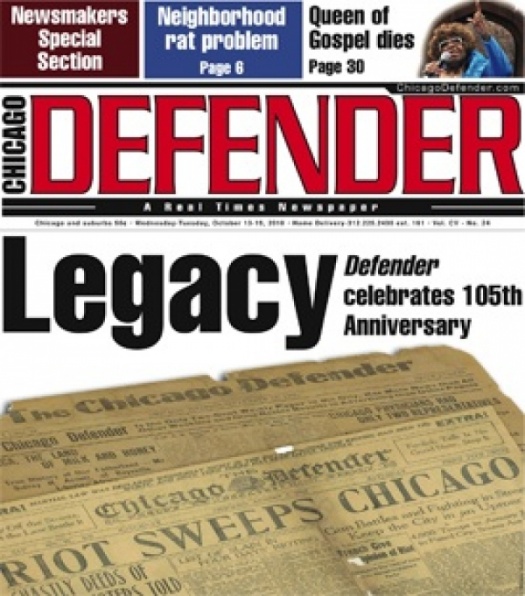
Myiti Sengstacke said when she was 12 years old her late grandfather, John H. Sengstacke, would ask her how he should address certain community issues in the Chicago Defender newspaper.
Myiti Sengstacke said when she was 12 years old her late grandfather, John H. Sengstacke, would ask her how he should address certain community issues in the Chicago Defender newspaper. “Here was a man who was a millionaire and he was asking me what I thought about a story,” Myiti, 38, told the Defender. “I really appreciated that he valued my opinion. Those are among the fondest memories I have of my grandfather.” John’s uncle, Robert Sengstacke Abbott, founded the Defender in a small kitchen in his landlord’s apartment in 1905, with an initial investment of 25 cents and a press run of 300 copies. The Defender’s first issues were in the form of four-page, six-column handbills, filled with local news items gathered by Abbott and clippings from other newspapers. Ownership of the newspaper passed to John Sengstacke upon Abbott’s death in 1940. And by 1965 Sengstacke Newspapers also owned The Pittsburgh Courier, The Michigan Chronicle in Detroit and The Tri-State Defender in Memphis. Myiti, who works for the Chicago Public Schools, would later join the family business when she turned 17 and work at the Defender by her grandfather’s side. “One of the first things he did (when I started at the Defender) was sit me down and show me all the advertisements in the paper. He explained that advertisements is how the paper made money,” she said. “During my time at the Chicago Defender I worked in the accounts receivable and editorial departments.” And after 51 years as a weekly, in 1956 John was able to transition the paper into a daily, an accomplishment his son – Myiti’s father – Bobby Sengstacke, said was among his proudest moments. John was the Defender’s owner until 1997 when he passed away. “The day the paper became a daily was a milestone for my dad who always said that as long as you help someone you would be OK,” Bobby, 67, said. “He brilliantly used the paper to help people. My dad was a true activist.” Bobby said the Defender during its heyday was the leading news source within the Black community. “Back then everybody read the Chicago Defender. Since the very beginning the Defender has been at the forefront of the African American journalism community,” explained Bobby. “(But) today, there is no unified voice among the Black Press.” He explained that the Defender was known for focusing on an issue and writing about it constantly until the community got sick of it and did something about it. Those stories included investigative pieces John often worked on, according to his nephew Thomas Sengstacke Picou. Bobby’s late mother Myrtle was Picou’s aunt. “John was a strong supporter of investigative stories,” said Picou, who now lives in Los Angeles. “I traveled the world with John. I must have visited the White House at least a dozen times with him.” Picou started working at the Defender in 1957 when he was 19 years old. During his tenure at the paper he served as a sports reporter, editor and president. Another Sengstacke family member said his fondest memories of his late uncle, John, was when he worked closely with several U.S. presidents, such as Franklin D. Roosevelt and Harry S. Truman, to integrate the military. In the 1960s Mark Sengstacke, 55, worked in the mailroom at the Defender but would later serve as the paper’s director of public relations and then coordinator for the Bud Billiken Parade and Picnic. He said his father, Fred Sengstacke, who died in 2009, once served as the Defender’s publisher. “This was a time when the Defender had a tremendous influence among the Black Press,” said Mark, assistant director of the Cook County Department of Environmental Control. Two years ago the Defender returned to its original weekly cycle at a time when many newspapers had either gone out of business or filed for bankruptcy protection to stay afloat. The newspaper, is now owned by Real Times Inc. Copyright 2010 Chicago Defender
